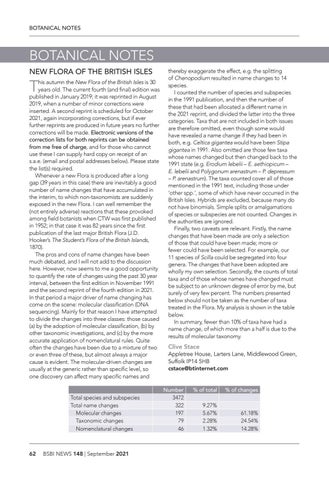BOTANICAL NOTES
BOTANICAL NOTES NEW FLORA OF THE BRITISH ISLES
T
his autumn the New Flora of the British Isles is 30 years old. The current fourth (and final) edition was published in January 2019; it was reprinted in August 2019, when a number of minor corrections were inserted. A second reprint is scheduled for October 2021, again incorporating corrections, but if ever further reprints are produced in future years no further corrections will be made. Electronic versions of the correction lists for both reprints can be obtained from me free of charge, and for those who cannot use these I can supply hard copy on receipt of an s.a.e. (email and postal addresses below). Please state the list(s) required. Whenever a new Flora is produced after a long gap (39 years in this case) there are inevitably a good number of name changes that have accumulated in the interim, to which non-taxonomists are suddenly exposed in the new Flora. I can well remember the (not entirely adverse) reactions that these provoked among field botanists when CTW was first published in 1952; in that case it was 82 years since the first publication of the last major British Flora (J.D. Hooker’s The Student’s Flora of the British Islands, 1870). The pros and cons of name changes have been much debated, and I will not add to the discussion here. However, now seems to me a good opportunity to quantify the rate of changes using the past 30 year interval, between the first edition in November 1991 and the second reprint of the fourth edition in 2021. In that period a major driver of name changing has come on the scene: molecular classification (DNA sequencing). Mainly for that reason I have attempted to divide the changes into three classes: those caused (a) by the adoption of molecular classification, (b) by other taxonomic investigations, and (c) by the more accurate application of nomenclatural rules. Quite often the changes have been due to a mixture of two or even three of these, but almost always a major cause is evident. The molecular-driven changes are usually at the generic rather than specific level, so one discovery can affect many specific names and
Total species and subspecies Total name changes Molecular changes Taxonomic changes Nomenclatural changes
62
BSBI NEWS 148 | September 2021
thereby exaggerate the effect, e.g. the splitting of Chenopodium resulted in name changes to 14 species. I counted the number of species and subspecies in the 1991 publication, and then the number of these that had been allocated a different name in the 2021 reprint, and divided the latter into the three categories. Taxa that are not included in both issues are therefore omitted, even though some would have revealed a name change if they had been in both, e.g. Celtica gigantea would have been Stipa gigantea in 1991. Also omitted are those few taxa whose names changed but then changed back to the 1991 state (e.g. Erodium lebelii – E. aethiopicum – E. lebelii and Polygonum arenastrum – P. depressum – P. arenastrum). The taxa counted cover all of those mentioned in the 1991 text, including those under ‘other spp.’, some of which have never occurred in the British Isles. Hybrids are excluded, because many do not have binomials. Simple splits or amalgamations of species or subspecies are not counted. Changes in the authorities are ignored. Finally, two caveats are relevant. Firstly, the name changes that have been made are only a selection of those that could have been made; more or fewer could have been selected. For example, our 11 species of Scilla could be segregated into four genera. The changes that have been adopted are wholly my own selection. Secondly, the counts of total taxa and of those whose names have changed must be subject to an unknown degree of error by me, but surely of very few percent. The numbers presented below should not be taken as the number of taxa treated in the Flora. My analysis is shown in the table below. In summary, fewer than 10% of taxa have had a name change, of which more than a half is due to the results of molecular taxonomy.
Clive Stace
Appletree House, Larters Lane, Middlewood Green, Suffolk IP14 5HB cstace@btinternet.com Number 3472 322 197 79 46
% of total
% of changes
9.27% 5.67% 2.28% 1.32%
61.18% 24.54% 14.28%

















